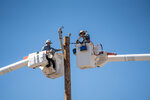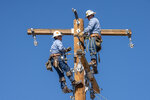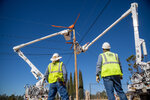Wind: 3.5 mph, N
Welcome to our new web site!
To give our readers a chance to experience all that our new website has to offer, we have made all content freely avaiable, through October 1, 2018.
During this time, print and digital subscribers will not need to log in to view our stories or e-editions.



(EDITOR’S NOTE: This is the first installment of “Powerlines,” an ongoing series from the Las Cruces Bulletin about our energy, our energy sources, and the always changing interactions we have as energy consumers.)
Monday, July 10, El Paso Electric company had peak energy use from its customers. Texas and New Mexico used more electricity in one hour than had ever been used in EPE’s system.
Then it expected another day like that, but rain and clouds cooled night temperatures and the demand for power didn’t exceed the supply.
Dave Hawkins, El Paso Electric’s vice president of system operations and resource strategy describes the electric grid like a highway system with mass transportation.
“It’s the same with the transmission grid for our system, starting from generating facilities,” he said, “it comes to southern New Mexico and West Texas, then we step that down to distribution level, like a puzzle put together of our resources.”
The Eastern, Western and Texas interconnections are the three power grids within the continental United States, Hawkins said. These interconnections use the same frequency within their interconnection grid which helps prevent major disturbances and supports power delivery to customers across the network. EPE is within the Western Interconnection and interfaces with other utilities in the southwestern United States.
He said outages happen for different reasons. In a neighborhood, the outage could be caused by a car hitting a pole. On a larger scale an outage could be caused either by not enough power generation or by the transmission being taken out of service.
“That is all very much part of our planning process,” he said. “We look at broader resources. There is oversight that looks to make sure that if a transmission goes out, how will we respond? We have to have a plan to address that.”
The planning is constant, Hawkins said. EPE looks at what it will do if it can’t generate enough power to serve communities. If there is a chance of failure, the company will reach out to neighboring systems to make sure there is enough. Those neighbors include PNM in New Mexico and Arizona Utilities in Tucson.
“We actually participate in a nuclear facility in Palo Verde (in southwestern Arizona),” he said. “It’s a large tower hub for other areas. We own about 16 percent of the Palo Verde facility.”
El Paso Electric owned resources are 25 percent nuclear, 71 percent natural gas and 4 percent solar. EPE provides electricity from electric generators sourced from various sources of fuel supply (nuclear, natural gas, and solar). This electricity is generated from electric generators owned by EPE or purchased through long- and short- term power agreements with other power producers.
“It’s been over 10-12 years since we had a problem – since the freeze (February 2011),” he said.
In heat like we are experiencing here in southern New Mexico, customer demand can be much higher than expected, he said. Energy use increases over that time and EPE is very aware, monitoring and maintaining system operations 24 hours a day.
EPE serves 460,000 total customers, 92,000 of those in New Mexico, Hawkins said.
When overnight temperatures stay high after the 105- to 109-degree days, EPE might struggle more to keep the energy flowing. People who are accustomed to opening the windows and turning the cooling down are not going to want to give up their cooler environment. That makes for higher usage of the transmission system, he said.
“On hot days, clouds move in (in the evening) we have a trapping of heat and the temperature is not dropping,” he said. “Where we see the greatest impact is rain. If it’s not going to rain, it would be better for clouds to move away so heat can escape.”
Hawkins said he thinks, for the most part, customers are pretty good about the conscientious use of energy. EPE offers help with plans and smart thermostats as well.
To learn about EPE’s energy efficiency programs, visit epelectric.com/renewables-tech/programs.
To learn about smart thermostats and other energy-saving products, visit nm.epelectricmarketplace.com.
“When customers take part, the company has the ability to give dollars back,” he said. “The company can work with customers on those programs. For example, when not home, raise the thermostat, saving energy that didn’t need to be produced.”
“When unforeseen circumstances do occur, EPE is ready to respond safely and quickly to restore power to our customers,” concludes a note in its 2022 Corporate Sustainability Report.